WASHINGTON, D.C. -- The U.S. Payroll to Population employment rate (P2P), as measured by Gallup, was 44.5% in May. This is up from 43.4% in April, and up slightly from 43.9% in May 2013. P2P continues to climb in the first half of 2014, recovering ground lost in the second half of 2013.
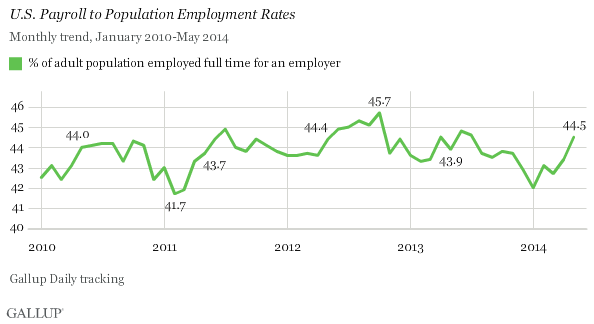
Gallup's P2P metric tracks the percentage of the U.S. adult population aged 18 and older that is employed full time by an employer for at least 30 hours per week. P2P is not seasonally adjusted. However, because of seasonal fluctuations, year-over-year comparisons are often helpful in evaluating whether monthly changes are attributable to seasonal hiring patterns or true growth (or deterioration) in the percentage of people working full time for an employer. Based on this comparison, the P2P rate for May 2014 was up slightly from the 43.9% found in the same month last year and is on par with the 44.4% measured in May 2012. The high in Gallup's five-year trend is 45.7% in October 2012.
The latest results are based on Gallup Daily tracking interviews with approximately 31,500 Americans, conducted May 1-31, by landline telephone and cellphone. Gallup does not count adults who are self-employed, working part time, unemployed, or out of the workforce as payroll-employed in the P2P metric.
Unadjusted Unemployment Is 7.0% in May
Unlike Gallup's P2P rate, which is a percentage of the total population, traditional employment metrics, such as the unemployment rates that Gallup and the U.S. Bureau of Labor Statistics (BLS) report, are percentages of the workforce. Gallup defines the "workforce" as adults who are working or actively looking for work and available for employment. The U.S. workforce participation rate in May was 67.6%, up from April's 66.0%, but still down from 68.4% in May 2013.
Gallup's unadjusted U.S. unemployment rate for May is 7.0%, similar to April's 7.1%, but down from 7.9% in May 2013. From a broad perspective, apart from some short-lived increases, unemployment has been trending down since early 2011, when it was 10.3%.
Gallup's seasonally adjusted U.S. unemployment rate for May is 7.2%. Gallup calculates this rate by applying the adjustment factor the government used for the same month in the previous year. Last year, the government adjusted May's rate upward by 0.2 points. The exact adjustment the government will use in May 2014 will not be known until Friday's BLS release.
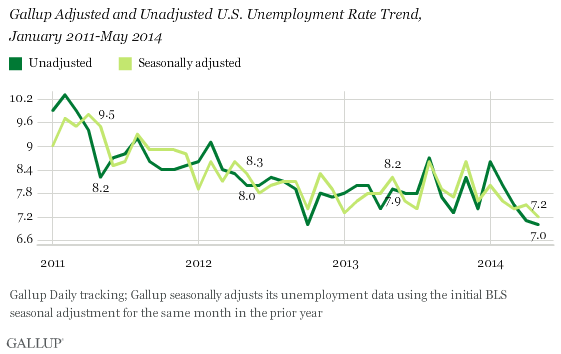
Gallup and BLS unemployment data are both based on large national samples, and Gallup's employment numbers generally correlate with BLS rates. However, the two surveys have important methodological differences, and the numbers will differ slightly from month to month.
Underemployment, as measured by Gallup without seasonal adjustment, was 16.4% in May. This is similar to the 16.6% in April and down from 18.0% in May 2013. Gallup's U.S. underemployment rate combines the percentage of adults in the workforce who are unemployed (7.0%) with those who are working part time but looking for full-time work (9.5%). Because of rounding, the combined underemployment measure is 16.4%, not 16.5%.
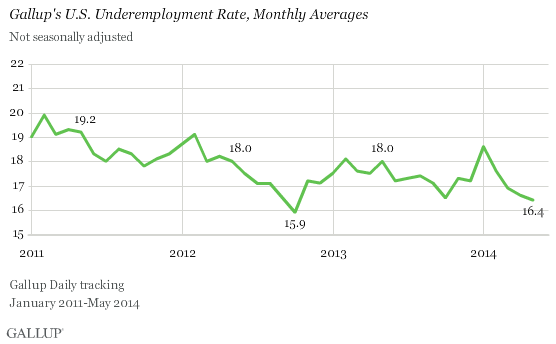
Bottom Line
As expected, P2P continued to climb in May as hiring typically increases in the spring and summer seasons. The P2P rate -- U.S. adults employed full time for an employer -- has generally been lowest in the first quarter and has risen in the second quarter of each year since Gallup began tracking it in January 2010. Even with the expected seasonal increase, P2P for this past month exceeds the P2P figure measured in May of the past three years. In recent months, P2P has lagged behind the performance in the same month in previous years, but this recent rise may signal a break from that pattern.
There is also some indication that optimism is rising among the unemployed. Among those who were unemployed this past month, 59% say they think they will have a job within the next four weeks. This is steady with May 2013, when 58% said so, and at least five percentage points above figures found in May 2012 (54%), 2011 (53%), and 2010 (53%).
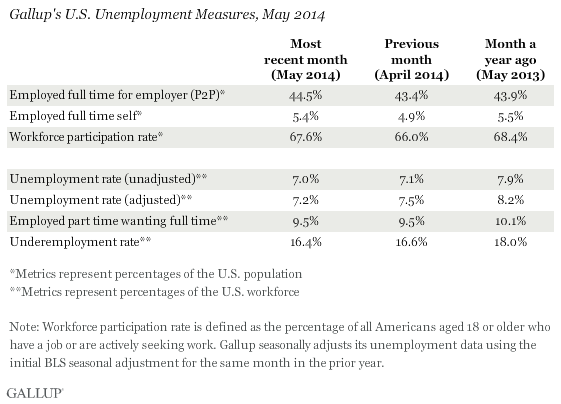
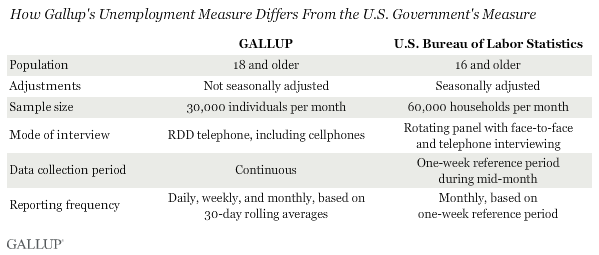
Gallup.com reports results from these indexes in daily, weekly, and monthly averages and in Gallup.com stories. Complete trend data are always available to view and export in the following charts:
Daily: Employment, Economic Confidence, Job Creation, Consumer Spending
Weekly: Employment, Economic Confidence, Job Creation, Consumer Spending
Read more about Gallup's economic measures.
View our economic release schedule.
Survey Methods
Results for this Gallup poll are based on telephone interviews conducted May 1-31, 2014, on the Gallup Daily tracking survey, with a random sample of 31,450 adults, aged 18 and older, living in all 50 U.S. states and the District of Columbia.
For results based on the total sample of national adults, the margin of sampling error is ±1 percentage points at the 95% confidence level.
Interviews are conducted with respondents on landline telephones and cellular phones, with interviews conducted in Spanish for respondents who are primarily Spanish-speaking. Each sample of national adults includes a minimum quota of 50% cellphone respondents and 50% landline respondents, with additional minimum quotas by time zone within region. Landline and cellular telephone numbers are selected using random-digit-dial methods. Landline respondents are chosen at random within each household on the basis of which member had the most recent birthday.
Samples are weighted to correct for unequal selection probability, nonresponse, and double coverage of landline and cell users in the two sampling frames. They are also weighted to match the national demographics of gender, age, race, Hispanic ethnicity, education, region, population density, and phone status (cellphone only/landline only/both, and cellphone mostly). Demographic weighting targets are based on the most recent Current Population Survey figures for the aged 18 and older U.S. population. Phone status targets are based on the most recent National Health Interview Survey. Population density targets are based on the most recent U.S. census. All reported margins of sampling error include the computed design effects for weighting.
In addition to sampling error, question wording and practical difficulties in conducting surveys can introduce error or bias into the findings of public opinion polls.
For more details on Gallup's polling methodology, visit www.gallup.com.
